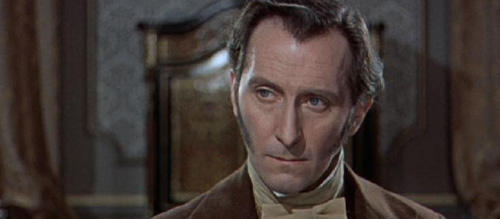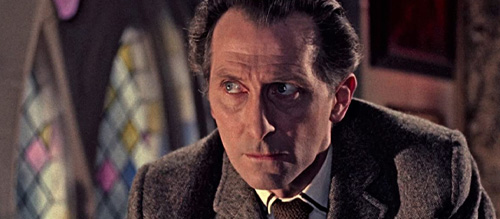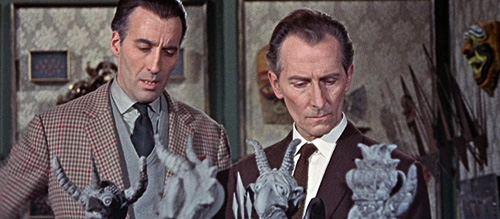Where to Start with the Cinema of Peter Cushing
In the near 30 years of his sad absence, the name Peter Cushing still manages to cause a stir amongst film lovers. The moment Guy Henry turns around in Disney’s Rogue One wearing the computer-generated face of the late actor from Surrey, England, cinemas around the world were filled with hushed awe. With Rogue One being one of the very best of Disney’s Star Wars output, the posthumous reappearance of the Grand Moff Tarkin remains a fan favourite scene in a film of countless iconic moments. Fans’ reactions to this single sequence confirm that those with cinematic curiosity who decide to explore the filmography of this remarkable actor will certainly not be alone. With an acting career spanning over six decades between the 1930s and 1980s, and boasting over one hundred credits, this cult icon has a little bit of something for everyone.
Initially attempting to forge a career in Hollywood during its Golden Age with the likes of The Man in The Iron Mask (1939) and Laurel and Hardy’s A Chump at Oxford (1939), Cushing found himself returning to Britain and the War Effort through his work in the Entertainment National Services Association. His first big film role came as Osric in Laurence Olivier’s Hamlet (1948) and he inadvertently became the face of the new and exciting enterprise that was British Television in the 1950s, starring in numerous live Teleplays. His real breakthrough into stardom was his lead role in Hammer Productions’ Curse of Frankenstein (1957); it being the first of what would become known as the Hammer Horrors, films that rekindled and dominated the then dead horror genre in glorious Eastman Colour. Cushing became one of the principal stars of these Hammer Horrors, usually acting opposite his long-time friend Christopher Lee whilst also being poached by rival horror production companies such as Amicus.
Throughout his career, Cushing has played several beloved figures of British popular culture and literature including Winston Smith of ‘1984’, Mr Darcy, Sherlock Holmes and even Sherlock’s creator Sir Arthur Conan Doyle. Not only did he take part in the Hollywood giant that is Star Wars, but he even played Dr. Who on the big screen. There is a certain je ne c’est quoi surrounding his performances: he embraced his work with a rare humility and with a full acceptance of his type-casting, thus he would treat every role like Shakespeare. He is nearly solely responsible for the entertainment value of the majority of mid 20th century British horror and sci-fi from the power of his screen presence alone, and thus to this day has an inexplicably strong following.
Dare you watch these following films and unwittingly be sucked into the Peter Cushing cult?
1. The Curse of Frankenstein (1957)

Before the Grand Moff Tarkin marched through the Death Star with Darth Vader on a leash, mercilessly destroying innocent planets with a cool and eloquent “Fire when ready”, there was Baron Victor Frankenstein.
There is a quiet reverence surrounding The Curse of Frankenstein. As the first coloured film adaptation of Mary Shelley’s novel, this modest British production is credited with the resurrection of the horror genre in cinema. Starting with an original concept of a black and white film with Boris Karloff, Universal Pictures lawyers snapping at the ankles of Hammer caused a major rewrite so as to stray as far away from Frankenstein (1931) as possible.
The most obvious changes are the creature’s make up and the special effects used in the creation scenes, but the most important changes are to the characters themselves. In both the book and James Whale’s film, Baron Frankenstein is a tragic figure and Colin Clive’s performance in the original Frankenstein movie is more like that of a misunderstood romantic hero. Cushing’s Frankenstein is a bastard. This new and startling characterisation, coupled with Cushing’s performance, represents the evolution of horror.
The fear factor of The Curse of Frankenstein‘s predecessors are based in the Supernatural: Frankenstein blinded by passion and a need to understand the unfathomable secrets of the universe perverts nature itself. The result is a melancholic affair, society’s rejection of the unnatural and the unknown; a pensive reflection on man’s pride and scientific folly.
In the case of The Curse of Frankenstein, the film’s horror stems entirely from the fact that Baron Victor Frankenstein is a psychopath. Even though Cushing’s Frankenstein is also misguided by scientific curiosity, the course of his creation is dominated by the total absence of a moral compass. He doesn’t hide away his creation but instead concocts his abomination in the very house he shares with his fiancée, unbothered by the concept of his creature escaping and wreaking havoc onto the nearby villagers. This version of Frankenstein also doesn’t hesitate to commit murder to further his own ends.
It is not merely the actions of the Baron that convince us of his villainy, it is of course the way he commits such acts. Whilst Colin Clive regarded the body parts and the corpse of his soon to be creation with an almost tenderness, Cushing plunders the bodies of the good and bad with a barely contained glee. The cocky self-assuredness of the Baron’s superior intelligence compared to others, coupled with a child-like petulance and an inability to accept blame for his own evil actions, makes for a truly deplorable yet lovable villain. Even though the first act of his creation once filled with life was to crush Victor Frankenstein’s throat and squeeze the very life out of him, Victor remains overjoyed that he has succeeded in creating life, be it one of pure evil. Truly, then, Frankenstein and his creation are a perfect match; surely this snarling creature filled with bloodlust is an extension of Victor’s own psychopathy – his cold disregard for other’s lives comes to fruition with the monster gobbling up the likes of an old blind man and his young grandson.
Cushing’s energetic performance fizzing with gleeful wickedness was key to reinventing horror as the gory, thrilling, action-packed genre it is known as today. Thus begins Peter Cushing’s long love affair with Shelley’s novel, the actor going on to play the Baron five more times.
2. The Brides of Dracula (1960)

Despite Peter Cushing being known for his wonderful turns as movie villains, his archetypal role stems from his part as Dr Van Helsing, originating in Hammer Films’ production Dracula (1958). Since its release, the whole filmography of British B Movies has been dominated by the universal truth that redemption will come in the shape of Peter Cushing, usually as some kind of doctor or scientist.
In the same way that Cushing is synonymous with Hammer Horror’s Frankenstein franchise, it is usually Christopher Lee that is associated with its Dracula series. Lee did, however, turn down the opportunity to reprise his role of Dracula in this, Hammer’s second vampire movie (he eventually returned to the role in Dracula: Prince of Darkness in 1966), and as such Brides of Dracula is very much the Peter Cushing show.
Often cited as a fan favourite, Brides of Dracula really is one of those perfect Hammer Horrors. A broad and talented cast, opulently dressed sets and gorgeous costumes mask Hammer’s modest budget. The time of its release in 1960 represented a point in Hammer Horror’s history in which the production company had managed to strike up the perfect thematic balance – a delicate concoction of revulsion and sex appeal.
The maintenance of Bride of Dracula‘s status as a campy horror can be almost completely attributed to Cushing’s performance. Many moments of the film are genuinely laughable: the vampire bat attacks were made with an inferior prop (as the proper one was stolen) and there is an overbearing use of Christian symbology, with probably at least fifty percent of the principle shooting involving crucifixes (not to mention constant and hilarious church organ movements throughout the film’s score).
Not for a moment is the film’s illusion shattered by unintentional comedy however, and this is all because of the sheer dedication of Cushing’s performance. Peter Cushing in all of his B movie career can never be accused of phoning it in, and Brides of Dracula is no exception. Through an absolutely straight performance in which Helsing brandishes his crucifix and holy water like the deadliest of weapons, we are able to put our full confidence behind this character and truly believe that he could hold back the forces of hell singlehandedly. Coupled with the intensity of the performance, Cushing’s Van Helsing makes for a beloved yet unexpected action hero.
With an almost shockingly gaunt appearance and most definitely in his late forties, Cushing’s Van Helsing is no Captain America. But, despite his mould as a mentor, Van Helsing is the one that gets his hands dirty as opposed to a younger protégée. With his secret weapon of a hidden sprightliness that is released in moments of antagonism, not only are his enemies bowled over but so are we – his release of this pent up energy tricks us into thinking we have watched a fight sequence comparable to that of current cinema, only far more interesting. Confrontations within Hammer Films, especially when Cushing is involved, have a swashbuckling quality rarely seen in the modern fight scenes of today’s motion pictures, which are rendered almost clinical in comparison.
What makes Cushing’s Van Helsing more captivating than modern action heroes is the portrayal of his human vulnerability. Many of the Hammer Horror movies have these fantastic moments of mortal peril at their climaxes, with Brides of Dracula boasting one of the most memorable. In the face of a possible conversion to vampirism, Helsing grips on to his humanity with the help of a hot iron and some holy water in a scene that solidifies him as one badass motherf*cker. Rarely do we see our modern heroes be put against such visceral and sumptuously gothic danger and not shrug it off mere seconds later, making the watching experience all the more satisfying. The infamy of this scene represents the startling originality of both Hammer and Cushing as well as their significance in horror evolution as they introduce gore and pain as necessities of the genre, perhaps the key elements that have had audiences returning to the these movies time and time again over the fifty years since they were released.
3. The Skull (1965)

The idea for the first true Hammer Horror originated from a script by Milton Subotsky, which was rejected and drastically rewritten for being too close to the Universal original. Not long afterwards, Subotsky would co-found his own Production Company to rival the horror output of Hammer itself – Amicus Productions. Throughout the 1960s, Hammer Films continued to dominate the British Horror scene and, consequentially, it was difficult for rival productions to shake off the studio’s influence. In comparison to Hammer’s gothic affairs, Amicus offered audiences Portmanteaus within a contemporary setting, illustrating how original ideas would always find their audience in the peak of British cinema’s boom.
This gave Cushing the opportunity to take a very different direction that wasn’t available to him from Hammer at that time, which maintained a very black and white approach to casting. It is through films such as The Skull that we are able to enjoy more ambiguous characters from Cushing; characters who are pushed to the limits of their sanity.
The Skull was adapted for the screen from a short story, “The Skull of the Marquis de Sade” by Robert Bloch (of “Psycho” fame). The Marquis de Sade, born in 1740, is the man whose name was used to create the term sadism: the film suggests that the Marquis’ depravity was caused by him being possessed by an evil force that still resides in his skull and is passed from one occult enthusiast to another. The skull finds itself in the lap of Christopher Maitland (Cushing), a man who researches into demonology to dispel the fear surrounding the objects associated with evil. His friend, Sir Matthew Phillips, warns him to get rid of the skull as many of its previous owners have met sticky ends, but alas his advice is ignored by his sceptical friend.
Fans of this particular era of British Horror can take themselves too seriously; usually as part of a defence mechanism when their love for essentially very camp and aged films is questioned. But there is no denying that The Skull is very silly. There was clearly a massive struggle in stretching the story to fit a feature length script, and as such there are lots of long sequences without any dialogue, usually involving a glowing skull flying around the house on unfortunately visible wires. Not every film produced needs to be a masterpiece however, and although The Skull is silly, it gives us all the more reason to watch it. Of course the entertainment value of all this silliness is hugely amplified by Cushing’s straight performance.
How does one take this film seriously? It shouldn’t be possible, but as we watch Cushing’s decent man be ensnared by the dark forces we find ourselves caught between wanting to laugh and being captivated. Cushing’s unhinged performance both thrills and fills us with glee as we are caught between the preposterous plot and our own investment into this character’s fate.
In a way, Peter Cushing in The Skull is comparable to Robert Eggers’ The Lighthouse. There is no use in trying to hold on to the plot, just sit back and enjoy the show of the actors chewing scenery as their characters descend into lunacy. In ignoring the bare plot, The Skull becomes a psychedelic nightmare where we can enjoy watching Cushing’s Maitland lose his mind in every creative way Amicus can muster, with highlights including camera shots from the skull’s point of view and a mostly mute, terrifying Kafkaesque trial sequence in which Maitland is forced into a game of Russian Roulette.
The most likely reaction from watching The Skull is unabashed peels of raucous laughter: is it from terror or from hilarity? Who knows, but at this point who cares? It isn’t the most enlightening way to spend 88 minutes but it is certainly one of the most entertaining, and without Peter Cushing the fine balance between the movie’s own ridiculousness and captivating quality would have been lost. Not only would the film have been poor, it would also be cursed with the worst possible outcome in cinema: being forgetful.
Recommended for you: Where to Start with Universal Classic Monsters
Thus lies the power behind Peter Cushing’s performances and why to this day he has such a strong following: not only does he shoulder so much of the entertainment value of countless movies, he has saved them from obscurity. Every single one of his performances through the years has been heartfelt and memorable and has thus instilled a magical quality into the films he has been featured in. He is well and truly the face of British horror and sci-fi, and we have him to thank for its survival so that we can enjoy these movies for many years to come.


Another great article! I love Cushing as Frankenstein and Van Helsing. His dedication to crafting all of his performances with the same care as if they were Shakespeare are a big reason for Hammer’s success.
I’ll just add my own opinion here – I’d replace The Skull with Captain Clegg (aka Night Creatures). I think my American ego gets a little thrill out of the Royal Navy getting soundly played by the “meek little villagers”.